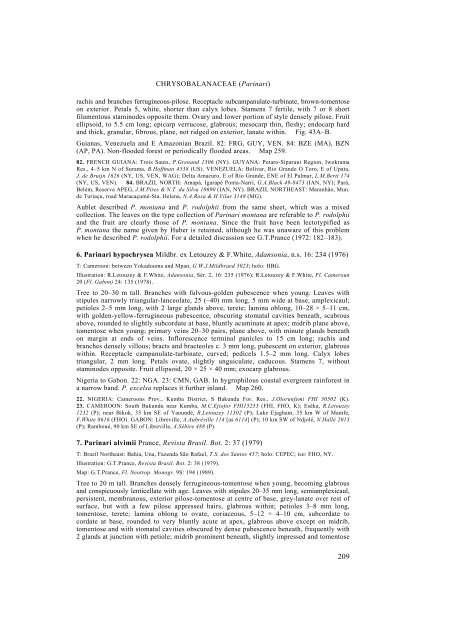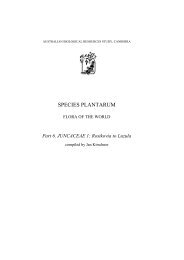Vol. 1 part 2 - Species Plantarum Programme
Vol. 1 part 2 - Species Plantarum Programme
Vol. 1 part 2 - Species Plantarum Programme
You also want an ePaper? Increase the reach of your titles
YUMPU automatically turns print PDFs into web optimized ePapers that Google loves.
CHRYSOBALANACEAE (Parinari)<br />
rachis and branches ferrugineous-pilose. Receptacle subcampanulate-turbinate, brown-tomentose<br />
on exterior. Petals 5, white, shorter than calyx lobes. Stamens 7 fertile, with 7 or 8 short<br />
filamentous staminodes opposite them. Ovary and lower portion of style densely pilose. Fruit<br />
ellipsoid, to 5.5 cm long; epicarp verrucose, glabrous; mesocarp thin, fleshy; endocarp hard<br />
and thick, granular, fibrous, plane, not ridged on exterior, lanate within. Fig. 43A–B.<br />
Guianas, Venezuela and E Amazonian Brazil. 82: FRG, GUY, VEN. 84: BZE (MA), BZN<br />
(AP, PA). Non-flooded forest or periodically flooded areas. Map 259.<br />
82. FRENCH GUIANA: Trois Sauts, P.Grenand 1506 (NY). GUYANA: Potaro-Siparuni Region, Iwokrama<br />
Res., 4–5 km N of Surama, B.Hoffman 4538 (US). VENEZUELA: Bolívar, Rio Grande O Toro, E of Upata,<br />
J. de Bruijn 1626 (NY, US, VEN, WAG); Delta Amacuro, E of Río Grande, ENE of El Palmar, L.M.Berti 174<br />
(NY, US, VEN). 84. BRAZIL NORTH: Amapá, Igarapé Ponta-Narri, G.A.Black 49-8473 (IAN, NY); Pará,<br />
Belém, Reserva APEG, J.M.Pires & N.T. da Silva 10690 (IAN, NY). BRAZIL NORTHEAST: Maranhão, Mun.<br />
de Turiaçu, road Maracaçumé-Sta. Helena, N.A.Rosa & H.Vilar 3148 (MG).<br />
Aublet described P. montana and P. rodolphii from the same sheet, which was a mixed<br />
collection. The leaves on the type collection of Parinari montana are referable to P. rodolphii<br />
and the fruit are clearly those of P. montana. Since the fruit have been lectotypified as<br />
P. montana the name given by Huber is retained, although he was unaware of this problem<br />
when he described P. rodolphii. For a detailed discussion see G.T.Prance (1972: 182–183).<br />
6. Parinari hypochrysea Mildbr. ex Letouzey & F.White, Adansonia, n.s. 16: 234 (1976)<br />
T: Cameroon: between Yokadouma and Mpan, G.W.J.Mildbraed 5023; holo: HBG.<br />
Illustration: R.Letouzey & F.White, Adansonia, Sér. 2, 16: 235 (1976); R.Letouzey & F.White, Fl. Cameroun<br />
20 (Fl. Gabon) 24: 135 (1978).<br />
Tree to 20–30 m tall. Branches with fulvous-golden pubescence when young. Leaves with<br />
stipules narrowly triangular-lanceolate, 25 (–40) mm long, 5 mm wide at base, amplexicaul;<br />
petioles 2–5 mm long, with 2 large glands above, terete; lamina oblong, 10–28 × 5–11 cm,<br />
with golden-yellow-ferrugineous pubescence, obscuring stomatal cavities beneath, scabrous<br />
above, rounded to slightly subcordate at base, bluntly acuminate at apex; midrib plane above,<br />
tomentose when young; primary veins 20–30 pairs, plane above, with minute glands beneath<br />
on margin at ends of veins. Inflorescence terminal panicles to 15 cm long; rachis and<br />
branches densely villous; bracts and bracteoles c. 3 mm long, pubescent on exterior, glabrous<br />
within. Receptacle campanulate-turbinate, curved; pedicels 1.5–2 mm long. Calyx lobes<br />
triangular, 2 mm long. Petals ovate, slightly unguiculate, caducous. Stamens 7, without<br />
staminodes opposite. Fruit ellipsoid, 20 × 25 × 40 mm; exocarp glabrous.<br />
Nigeria to Gabon. 22: NGA. 23: CMN, GAB. In hygrophilous coastal evergreen rainforest in<br />
a narrow band. P. excelsa replaces it further inland. Map 260.<br />
22. NIGERIA: Cameroons Prov., Kumba District, S Bakundu For. Res., J.Olorunfemi FHI 30502 (K).<br />
23. CAMEROON: South Bakundu near Kumba, M.C.Ejiofor FHI15253 (FHI, FHO, K); Eséka, R.Letouzey<br />
1232 (P); near Bikok, 35 km SE of Yaoundé, R.Letouzey 11302 (P); Lake Ejagham, 35 km W of Mamfe,<br />
F.White 8616 (FHO). GABON: Libreville, A.Aubréville 114 [as 6114] (P); 10 km SW of Ndjolé, N.Hallé 2013<br />
(P); Ramboué, 90 km SE of Libreville, A.Sébire 488 (P).<br />
7. Parinari alvimii Prance, Revista Brasil. Bot. 2: 37 (1979)<br />
T: Brazil Northeast: Bahia, Una, Fazenda São Rafael, T.S. dos Santos 457; holo: CEPEC; iso: FHO, NY.<br />
Illustration: G.T.Prance, Revista Brasil. Bot. 2: 38 (1979).<br />
Map: G.T.Prance, Fl. Neotrop. Monogr. 9S: 194 (1989).<br />
Tree to 20 m tall. Branches densely ferrugineous-tomentose when young, becoming glabrous<br />
and conspicuously lenticellate with age. Leaves with stipules 20–35 mm long, semiamplexicaul,<br />
persistent, membranous, exterior pilose-tomentose at centre of base, grey-lanate over rest of<br />
surface, but with a few pilose appressed hairs, glabrous within; petioles 3–8 mm long,<br />
tomentose, terete; lamina oblong to ovate, coriaceous, 5–12 × 4–10 cm, subcordate to<br />
cordate at base, rounded to very bluntly acute at apex, glabrous above except on midrib,<br />
tomentose and with stomatal cavities obscured by dense pubescence beneath, frequently with<br />
2 glands at junction with petiole; midrib prominent beneath, slightly impressed and tomentose<br />
209












